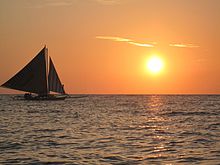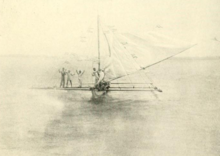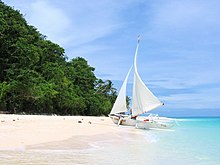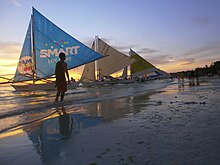
A sailing vessel's rig is its arrangement of masts, sails and rigging. Examples include a schooner rig, cutter rig, junk rig, etc. A rig may be broadly categorized as "fore-and-aft", "square", or a combination of both. Within the fore-and-aft category there is a variety of triangular and quadrilateral sail shapes. Spars or battens may be used to help shape a given kind of sail. Each rig may be described with a sail plan—formally, a drawing of a vessel, viewed from the side.
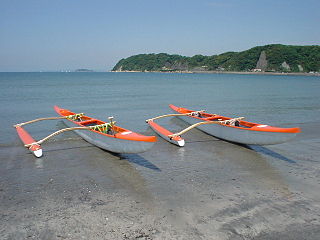
Outrigger boats are various watercraft featuring one or more lateral support floats known as outriggers, which are fastened to one or both sides of the main hull. They can range from small dugout canoes to large plank-built vessels. Outrigger boats can also vary in their configuration, from the ancestral double-hull configuration (catamarans), to single-outrigger vessels prevalent in the Pacific Islands and Madagascar, to the double-outrigger vessels (trimarans) prevalent in Island Southeast Asia. They are traditionally fitted with Austronesian sails, like the crab claw sails and tanja sails, but in modern times are often fitted with petrol engines.

Proas are various types of multi-hull outrigger sailboats of the Austronesian peoples. The terms were used for native Austronesian ships in European records during the Colonial era indiscriminately, and thus can confusingly refer to the double-ended single-outrigger boats of Oceania, the double-outrigger boats of Island Southeast Asia, and sometimes ships with no outriggers or sails at all.
Canoe sailing refers to the practice of fitting an Austronesian outrigger or Western canoe with sails.

The crab claw sail is a fore-and-aft triangular sail with spars along upper and lower edges. The crab claw sail was first developed by the Austronesian peoples by at least 2000 BCE. It is used in many traditional Austronesian cultures in Island Southeast Asia, Micronesia, Island Melanesia, Polynesia, and Madagascar. It is sometimes known as the Oceanic lateen or the Oceanic sprit, even though it is not restricted to Oceania, is neither a lateen sail nor a spritsail, and has an independent older origin.

The vinta is a traditional outrigger boat from the Philippine island of Mindanao. The boats are made by Sama-Bajau, Tausug and Yakan peoples living in the Sulu Archipelago, Zamboanga peninsula, and southern Mindanao. Vinta are characterized by their colorful rectangular lug sails (bukay) and bifurcated prows and sterns, which resemble the gaping mouth of a crocodile. Vinta are used as fishing vessels, cargo ships, and houseboats. Smaller undecorated versions of the vinta used for fishing are known as tondaan.

Villa de Arevalo, commonly known as simply Villa or Arevalo, is a district in Iloilo City, in the province of Iloilo, on the island of Panay in Western Visayas region, in the Philippines. According to the 2020 census, it has a population of 55,476 people. Arevalo is situated as the westernmost district of Iloilo City and shares its border with Oton to the west.
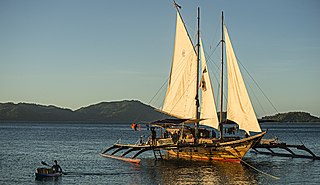
A balangay, or barangay, is a type of lashed-lug boat built by joining planks edge-to-edge using pins, dowels, and fiber lashings. They are found throughout the Philippines and were used largely as trading ships up until the colonial era. The oldest known balangay are the Butuan boats, which have been carbon-dated to 320 AD and were recovered from several sites in Butuan, Agusan del Norte.
The saintoise or canot saintois is a fishing boat without a deck, traditionally maneuverable with the sail or the ream. It is native to the les Saintes archipelago where it spread throughout the Lesser Antilles. The saintoise is an integral part of the heritage and the cultural identity of the archipelago. The practice of using sailing saintoises developed quickly in Guadeloupean water sports since 2001 when it officially became a new sport, the traditional sailboat racing.

The Paraw Regatta Festival or Iloilo–Guimaras Paraw Regatta Festival is an annual festival held every third weekend of February in the Arevalo, Iloilo City, Philippines. Its main event is a sailboat race in Iloilo Strait that features the paraw, a Visayan double-outrigger sail boat. It is the oldest traditional craft event in Asia, and the largest sailing event in the Philippines. It is one of Iloilo City's tourism events along with the Dinagyang Festival, Kasadyahan Festival, Chinese New Year festival and La Candelaria Fiesta. The Iloilo Paraw Regatta began as a half-day sailboat race but is now a multi-day, multi-event festival.

A sail is a tensile structure, which is made from fabric or other membrane materials, that uses wind power to propel sailing craft, including sailing ships, sailboats, windsurfers, ice boats, and even sail-powered land vehicles. Sails may be made from a combination of woven materials—including canvas or polyester cloth, laminated membranes or bonded filaments, usually in a three- or four-sided shape.

Karakoa were large outrigger warships from the Philippines. They were used by native Filipinos, notably the Kapampangans and the Visayans, during seasonal sea raids. Karakoa were distinct from other traditional Philippine sailing vessels in that they were equipped with platforms for transporting warriors and for fighting at sea. During peacetime, they were also used as trading ships. Large karakoa, which could carry hundreds of rowers and warriors, were known as joangas by the Spanish.

Garay were traditional native warships of the Banguingui people in the Philippines. In the 18th and 19th centuries, they were commonly used for piracy by the Banguingui and Iranun people against unarmed trading ships and raids on coastal settlements in the regions surrounding the Sulu Sea.
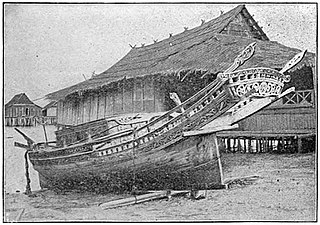
Lepa, also known as lipa or lepa-lepa, are indigenous ships of the Sama-Bajau people in Indonesia, the Philippines, and Malaysia. They were traditionally used as houseboats by the seagoing Sama Dilaut. Since most Sama have abandoned exclusive sea-living, modern lepa are instead used as fishing boats and cargo vessels.

Bangka are various native watercraft of the Philippines. It originally referred to small double-outrigger dugout canoes used in rivers and shallow coastal waters, but since the 18th century, it has expanded to include larger lashed-lug ships, with or without outriggers. Though the term used is the same throughout the Philippines, "bangka" can refer to a very diverse range of boats specific to different regions. Bangka was also spelled as banca, panca, or panga in Spanish. It is also known archaically as sakayan.
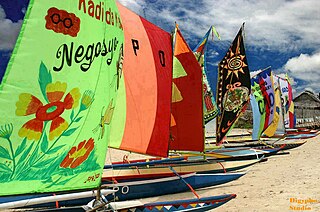
Bigiw is a small double-outrigger sailboat native to the islands of Mindanao, Visayas, and Palawan in the Philippines. It is used for personal transport or small-scale fishing and can hold one to three people. It is traditionally propelled by sails and steered with a single oar, but is commonly motorized in modern times. It can also be paddled. The sail type used is predominantly triangular crab claw sails, but it can also use spritsails or tanja sails.
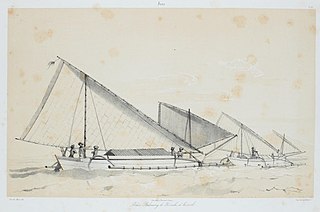
Paduwang is a traditional double-outrigger vessel from Madura, Indonesia. It is built with planks instead of single log, and used for fishing, trading and transport of people and goods near Madura island. In the 19th century, Paduwang was a popular fishing craft in East Java.
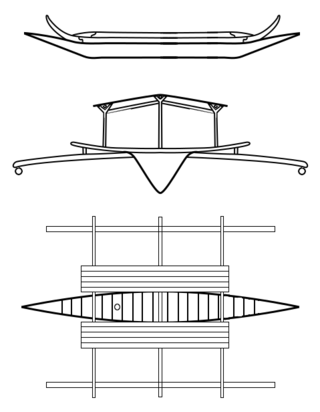
Djenging is a type of large double-outrigger plank boat built by the Sama-Bajau people of the Philippines. It is typically used as a houseboat, though it can be converted to a sailing ship. It was the original type of houseboat used by the Sama-Bajau before it was largely replaced by the lepa after World War II. Larger versions of djenging were also known as balutu or kubu, often elaborately carved with bifurcated extensions on the prow and stern.

Burulan is a Visayan term referring to fighting platforms on the traditional large trimaran warships (balangay) of the Philippines. They were made from bamboo and were distinctively raised from the deck. They carried the warrior-nobility of the Visayans and other passengers during travel, naval warfare, and seasonal coastal raids (mangayaw), so as to avoid interfering with the paddlers. This platform can be covered by an awning of woven palm leaves during hot days or when it rains, protecting the crew and cargo.

Austronesian vessels are the traditional seafaring vessels of the Austronesian peoples of Taiwan, Maritime Southeast Asia, Micronesia, coastal New Guinea, Island Melanesia, Polynesia, and Madagascar. They also include indigenous ethnic minorities in Vietnam, Cambodia, Myanmar, Thailand, Hainan, the Comoros, and the Torres Strait Islands.

